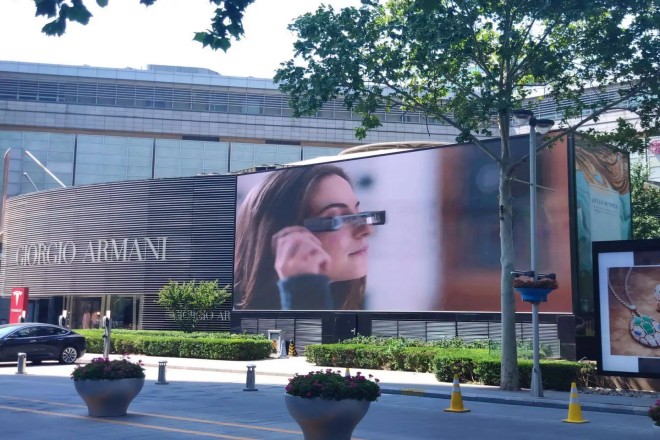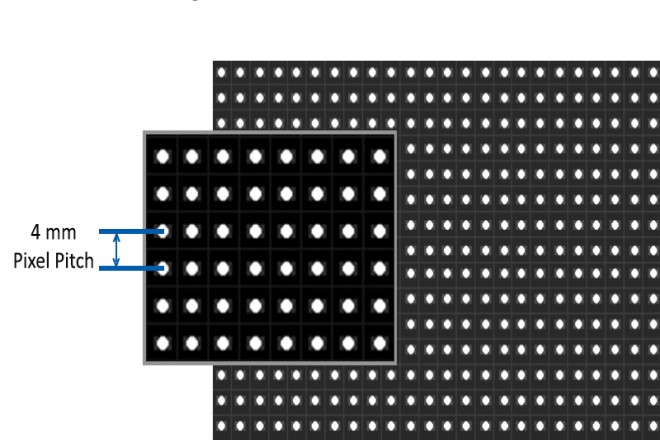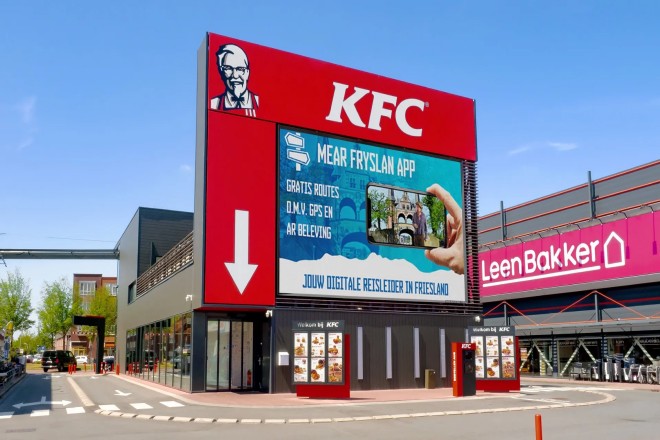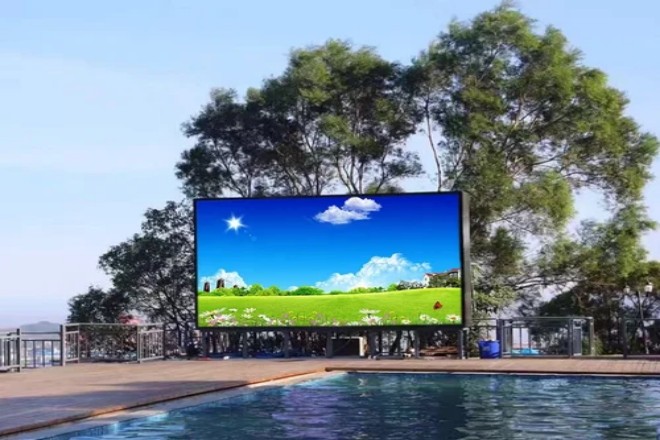مقدمة

In the field of outdoor advertising and information display, شاشات عرض LED have become the preferred display medium with their excellent visual effects and durability.
However, faced with many “P” value options, users often wonder: Which “P” value LED display screen can provide the best display effect? This article will reveal this mystery to you and help you make a wise choice.
1. What is the "P" value of outdoor LED display screens

The “P” value of شاشات عرض LED خارجية is a key parameter that represents the pixel pitch on the LED display screen. This concept is an important standard for measuring the fineness of the display screen, usually in millimeters (mm).
For example, P2 means that the spacing between every two pixels is 2mm, P2.5 is 2.5mm, and so on. P3 represents a pixel spacing of 3mm.
The smaller the “P” value, the closer the distance between the pixels and the more pixels per unit area.
So, what is the relationship between the “P” value and the display effect of the LED display screen?
Pixel density: In the same size area, the smaller the “P” value, the more pixels there are, so the higher the pixel density. High pixel density can present more delicate and clear images.
Clarity: Under the same display area, the smaller the “P” value of the display can provide a clearer image. This is because the smaller pixel pitch makes the image richer in detail and reduces the graininess and blur.
2. Key factors affecting the outdoor LED display effect

1). عرض المسافة
Viewing distance is an important factor in determining the selection of the “P” value of the outdoor LED display.
- Close viewing:
If the audience is close to the display, such as a commercial street, a small square, etc., or needs to display detailed images or text, you can choose a display with a smaller pixel pitch, that is, a display with a smaller “P” value, such as P2.5, P3, P3.91, P4 or P5, etc., to ensure clear transmission of information.
- المشاهدة عن بعد:
If the audience is far away from the display screen, such as highways, airports, railway stations, squares, stadiums, etc., or the clarity requirement is not particularly high, you can choose a display screen with a larger مساحة وحدة الصورة, that is, a display screen with a larger “P” value, such as P8, P10, P16, P20, P25, P31.25, etc., to ensure that the information is still clearly visible at a long distance and in complex light environments.
2). Screen size of LED display screen
The screen size of the LED display screen is also an important factor affecting the display effect of outdoor LED display screens.
- Small screen:
For display screens with a smaller area, such as within 10 square meters, P6 may be a better choice. A smaller “P” value can improve the clarity of a small screen and make its display content more delicate.
- Large screen:
If the area is between 20 and 100 square meters and the viewing distance is 10 meters away, P10 may be a more suitable choice; if the area is greater than 100 square meters, P16 or larger sizes may be more suitable to maintain sufficient viewing distance and clarity.
For large outdoor advertising screens, P10 and P16 are usually better choices due to their higher brightness and larger viewing distance.
Of course, when choosing the “P” value for a large screen, it is also necessary to make flexible choices based on budget and needs to achieve the best display effect and economic benefits.
3). Environmental conditions
The outdoor environment is complex and changeable, which places higher requirements on the display effect of the LED display.
The outdoor display needs to have a higher brightness to ensure that the information can still be clearly displayed under direct sunlight. The brightness of common outdoor LED display screens is generally above 6500cd/m².
- أداء مقاوم للماء:
The outdoor environment also has high requirements for the waterproof performance of the display screen to ensure that the display screen can still work normally in rainy and snowy weather.
Therefore, when choosing an outdoor LED display screen, you need to choose a product with good waterproof performance.
These environmental conditions may indirectly affect the choice of the “P” value. For example, in an outdoor environment with high brightness, you may need to choose a display screen with a slightly larger pixel pitch but higher brightness to ensure that the information is still clearly visible at a long distance and under strong light.
In an environment with high requirements for waterproof performance, you need to choose a display screen that has been specially treated and has good waterproof performance.
3. Common "P" values for outdoor LED displays

The “P” values for outdoor LED displays that are more common on the market include P4, P5, P6, P8, P10, etc.
1). P4 and P5
- السيناريوهات القابلة للتطبيق:
P4 and P5 displays are suitable for occasions with certain requirements for image clarity and moderate viewing distance, such as لوحات إعلانية LED خارجية, public information display screens, commercial streets, pedestrian streets, etc.
- عرض المسافة:
Due to the small pixel pitch, these displays are suitable for close viewing and can present a more delicate image effect.
2). P6 and P8
- السيناريوهات القابلة للتطبيق:
P6 and P8 displays are suitable for outdoor applications viewed from medium and long distances, such as billboards, building exteriors, squares, الملاعب، إلخ.
- عرض المسافة:
These displays have a more reasonable cost-effectiveness ratio while maintaining high clarity, are suitable for viewing from medium and long distances, and can ensure the readability of information under different light conditions.
3). P10
- السيناريوهات القابلة للتطبيق:
P10 displays are suitable for large outdoor advertising screens viewed from a distance, such as highways, المطارات، محطات السكك الحديدية، وما إلى ذلك.
- عرض المسافة:
Due to the large pixel pitch, these displays can still maintain good clarity when viewed from a distance, while the cost is relatively low, making them suitable for large-scale use.
4. Practical advice on choosing the "P" value for outdoor LED displays

1). Budget considerations
- Cost-benefit analysis:
Displays with high density (i.e., small P values) are usually more expensive because they require more lamp beads and more complex manufacturing processes.
Therefore, when choosing a P value, it is necessary to weigh it against the budget to ensure that the selected display has a good cost-effectiveness while meeting the usage requirements.
- عائد الاستثمار على المدى الطويل:
Although high-density displays have a larger initial investment, they usually provide clearer and more detailed pictures, resulting in better visual effects and user experience.
This may help enhance the brand image, attract more viewers or customers, and achieve a long-term return on investment.
2). Professional consultation
- Supplier advice:
It is very important to consult a professional LED display supplier or manufacturer before purchasing. They can provide customized advice and solutions based on your specific needs (such as usage scenarios, viewing distance, resolution requirements, etc.).
- الدعم الفني:
Professional suppliers can also provide technical support and after-sales service to ensure that the display screen is fully protected during installation, debugging, and use.
3). Other factors
- Use scenarios:
Different usage scenarios have different requirements for the P value of the display screen. For example, indoor small-pitch scenes (such as government conference halls or monitoring centers) usually choose P0.8 to P1.9 models。
Indoor high-definition scenes (such as conference rooms or exhibition halls) are suitable for P2 to P3 models; and outdoor or large event venues (such as hotel banquet halls or restaurant stage backgrounds) are more suitable for P4 and P5 models.
- عرض المسافة:
Viewing distance is also an important consideration when choosing the P value. Generally speaking, the closer the viewing distance, the smaller the required P value; the farther the viewing distance, the larger the P value can be selected.
This is because a smaller P value can provide higher resolution and clearer pictures, which is suitable for close viewing, while a larger P value can maintain the clarity and readability of the picture at a distance.
- تأثير العرض:
In addition to resolution and clarity, it is also necessary to consider parameters such as brightness, contrast and color saturation of the display. These parameters have an important impact on the display effect, so they also need to be paid attention to when choosing the P value.
خاتمة
Choosing the appropriate “P” value for outdoor LED display screens requires careful consideration of viewing distance, screen size, environmental conditions, and budget. There is no absolute “best,” only the solution that best suits your needs.
I hope the analysis and suggestions in this article can help you find the LED display that can meet your visual needs and fit your budget, making your information delivery more efficient and vivid.
أخيرًا، إذا كنت تريد معرفة المزيد عن شاشات LED، يرجى الحصول على اتصال معنا.
